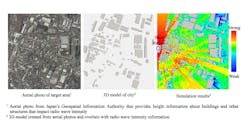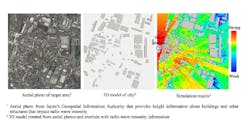While the 2017 IMS carries a theme in support of 5G, Mitsubishi Electric (booth No. 1827) comes to the exhibition on the heels of having released details on their electromagnetic (EM) simulation efforts on behalf of Internet of Things (IoT) technology. By using aerial photographs and available details about an area, the company is able to create three-dimensional (3D) models of cities to quickly and precisely visualize the paths and patterns of radio waves in an area (see figure). The tool can determine the best locations for wireless routers and base stations when building wireless networks.
Using aerial photographs and other details, a tool creates 3D models of cities for visualizing the directions of radio-wave travel. (Courtesy of Mitsubishi Electric)Using aerial photographs and other details, a tool creates 3D models of cities for visualizing the directions of radio-wave travel. (Courtesy of Mitsubishi Electric)
The modeling approach incorporates the ray-trace technique for measuring radio-wave intensity and builds a statistical model of the radio-wave attenuation characteristics based on physical characteristics and obstructions for an area. It is claimed to speed and simplify the placement of wireless infrastructure equipment in wireless networks, including for IoT devices.
About the Author
Jack Browne
Technical Contributor
Jack Browne, Technical Contributor, has worked in technical publishing for over 30 years. He managed the content and production of three technical journals while at the American Institute of Physics, including Medical Physics and the Journal of Vacuum Science & Technology. He has been a Publisher and Editor for Penton Media, started the firm’s Wireless Symposium & Exhibition trade show in 1993, and currently serves as Technical Contributor for that company's Microwaves & RF magazine. Browne, who holds a BS in Mathematics from City College of New York and BA degrees in English and Philosophy from Fordham University, is a member of the IEEE.


